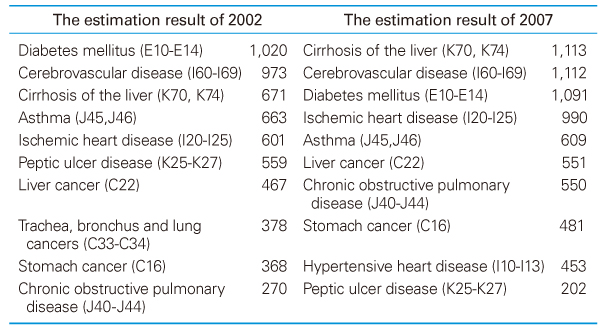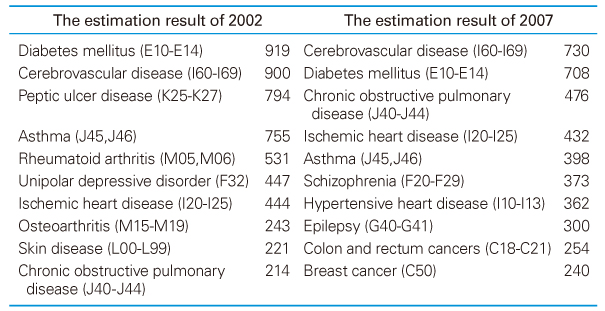 |
 |
- Search
| J Korean Med Assoc > Volume 54(6); 2011 > Article |
Abstract
The disability adjusted life year (DALY), a single indicator of the burden of disease, is widely used to measure the burden of diseases, injuries, and risk factors. In this study, we review the relative sizes of the burden of disease worldwide and the characteristics of the burden of disease of the Korean population. Future research directions for study of the burden of disease in Korea are also suggested. In the Korean population, diabetes mellitus was the leading cause of the burden of disease (970 DALYs per 100,000 population) in 2002, followed by cerebrovascular disease (937 DALYs per 100,000 population) and asthma (709 DALYs per 100,000 population), which differed with the leading causes of the burden of disease globally: unipolar depressive disorder, ischemic heart disease, and cerebrovascular disease. In 2007, cirrhosis of the liver in males and cerebrovascular disease in females became the leading causes of the burden of disease of the Korean population with the epidemiologic transition. Despite the methodological difference with global burden of disease study, these findings represent the characteristics of the burden of disease in Korea. Though many studies have been conducted to measure the burden of disease in Korea, there is a need to go beyond these to combine policymaking for resource allocation, such as cost effectiveness analysis, with burden of disease studies.
Acknowledgement
This study was supported by a grant from the National R&D Program for Cancer Control, Ministry of Health & Welfare, Republic of Korea (Grant No:1020310).
References
1. World Health Organization. Global health risks: mortality and burden of disease attributable to selected major risks 2009;Geneva: World Health Organization.
2. Yoon SJ, Bae SC. Current scope and perspective of burden of disease study based on health related quality of life. J Korean Med Assoc 2004;47:600-602.
3. Yoon SJ. Composite health indicators for mortality and morbidity. J Korean Med Assoc 1999;42:1175-1181.
4. Murray CJ. Quantifying the burden of disease: the technical basis for disability-adjusted life years. Bull World Health Organ 1994;72:429-445.
5. Lee H, Yoon SJ, Ahn HS. Measuring the burden of major cancers due to smoking in Korea. Cancer Sci 2006;97:530-534.
6. Shin YS, Yoon SJ, Park HJ. The method for burden of disease: for evidence based health policy making 2004;Seoul: Kyungmunsa.
7. Global burden of disease [Internet]. World Health Organization 2011;cited 2011 May 20. Geneva: World Health Organization. Available from: http://www.who.int/healthinfo/global_burden_disease/en/
8. Murray CJ, Lopez AD. The global burden of disease: a comprehensive assessment of mortality and disability from diseases, injuries, and risk factors in 1990 and projected to 2020 1996;Boston: Havard University Press.
9. Mathers CD, Ezzati M, Lopez AD. Measuring the burden of neglected tropical diseases: the global burden of disease framework. PLoS Negl Trop Dis 2007;1:e114.
10. Mathers C, Fat DM, Boerma J. The global burden of disease: 2004 update 2008;Geneva: World Health Organization.
11. Mont D. Measuring health and disability. Lancet 2007;369:1658-1663.
12. Anand S, Hanson K. Disability-adjusted life years: a critical review. J Health Econ 1997;16:685-702.
13. Lake RJ, Cressey PJ, Campbell DM, Oakley E. Risk ranking for foodborne microbial hazards in New Zealand: burden of disease estimates. Risk Anal 2010;30:743-752.
14. Mooney G, Irwig L, Leeder S. Priority setting in health care: unburdening from the burden of disease. Aust N Z J Public Health 1997;21:680-681.
15. Kim YM, Kim JW, Lee HJ. Burden of disease attributable to air pollutants from municipal solid waste incinerators in Seoul, Korea: a source-specific approach for environmental burden of disease. Sci Total Environ 2011;409:2019-2028.
16. Lee H, Yoon SJ, Ahn HS, Moon OR. Estimation of potential health gains from reducing multiple risk factors of stroke in Korea. Public Health 2007;121:774-780.
17. Park JH, Yoon SJ, Lee HY, Cho HS, Lee JY, Eun SJ, Park JH, Kim Y, Kim YI, Shin YS. Estimating the burden of psychiatric disorder in Korea. J Prev Med Public Health 2006;39:39-45.
18. Bae SC, Lee SI, Yoon SJ, Yim J, Hong DH, Do YK, Lee JY, Park JH, Eun SJ, Park JH, Jung SH, Jo MW, Hwang IA, Park KS, Kim HJ. A study on improvement of health-related quality of life by measurement of disease burden in Korea 2005;Seoul: Ministry of Health and Welfare.
19. Yoon SJ, Bae SC, Lee SI, Chang H, Jo HS, Sung JH, Park JH, Lee JY, Shin Y. Measuring the burden of disease in Korea. J Korean Med Sci 2007;22:518-523.
20. Yoon SJ, Kim EJ, Kim HJ, Kim SY, Jo MW, Hwang RI, Hong SW. A study on research methodology and long-term planning regarding estimating of economic burden of major diseases in Korea 2009;Seoul: Korean Centers for Disease Control and Prevention.
21. Park JH, Shin Y, Lee SY, Lee SI. Antihypertensive drug medication adherence and its affecting factors in South Korea. Int J Cardiol 2008;128:392-398.
22. Hutubessy RC, Baltussen RM, Torres-Edejer TT, Evans DB. Generalised cost-effectiveness analysis: an aid to decision making in health. Appl Health Econ Health Policy 2002;1:89-95.
- TOOLS
-
METRICS

-
Related articles in
J Korean Med Assoc -
Current status of scabies in Korea2023 December;66(12)
Prevalence and treatment status of diabetes mellitus in Korea2023 July;66(7)
Renal diseases causing hematuria2023 June;66(6)
Current status of health promotion in Korea2022 December;65(12)
Visual impairment and low vision in Korea2022 November;65(11)








